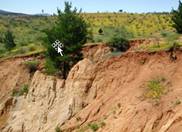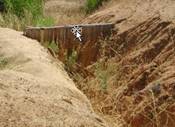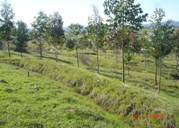Main reason for selecting this site
Erosion is the main cause of degradation of the soils in Chile. (Figure 3) Due to the topographic conformation of the country, with two large mountain ranges along the country, the Coastal mountain range close to the Pacific Ocean and the Andes mountain range, and the rain intensity and distribution, which is highly concentrated in winter, water erosion is the most important form of soil degradation. With a territorial area of 75.49 M ha, 46% (34.491 M has) are affected by erosion of different degrees; 7% of soils presents a severe erosion, while 27% are highly eroded, 44% moderately degraded and 22% are in state of light erosion degree (IREN, 1979).
 |
 |
 |
Figure 3: Erosion and some control strategies used in the study area.
In the Mediterranean climate area of Central Chile, in particular the interior dryland of central Chile (32° - 37° S), soil degradation and desertification are actually the main environmental problems. The interior dryland corresponds to the long narrow strip including the central Depression, and the western portions of the coastal foothills known as the Coastal Cordillera (Figure 1). Most of this 1.6 million ha is occupied by a traditional agricultural system that combines natural pasture with livestock activities and cereal production. As a result of the prevailing land use systems, about two thirds of interior dryland soils are badly eroded (IREN, 1965), and soil organic matter and microbial biomass are very low in many places (Ovalle, et al., 1990). At macro regional level, the erosion has provoked environmental imbalances, like siltation of rivers and ports, and serious problems of floods as much as rural level as in the cities.
The participation of the Chilean team in the project DESIRE is important for the State of Chile, for the regional Governments of the areas in study, and for farmers. It is expected that this project will contributes to the rehabilitation and development of one of the most economically depressed areas of the country, with high levels of rural poverty and degradation of the natural resources. In particular, it is expected that appropriate technologies for the sustainable management of these fragile soils will be transfer to farmers and associations, institutions and technical staff involve in soil conservation and local governments. A concrete contribution is expected in the area of the development of production systems through the incorporation of cover crops and agroforestry systems with multi-purpose trees and pastures, and the development of new crop systems and crop rotations with incorporation no tillage of cultivation systems. Besides, studying how to improve agronomic practices would enable increased soil fertility and the productive potential of this extensive area of the country.